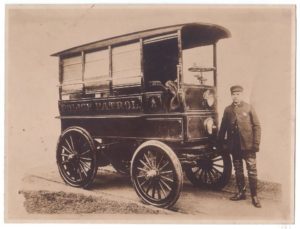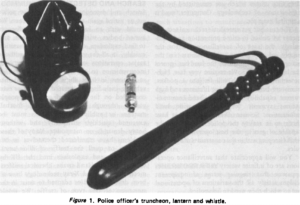Policing has always asked its officers to make difficult decisions about the nature of law enforcement. But three decades of advancements in police technology introduced a new level of complexity to those choices.
Most police executives rose through the ranks fully expecting – perhaps even motivated – to tackle systemic barriers to effective law enforcement. However, few could have anticipated the rapid changes to the public perception of policing’s role in society and the national spotlight that’s been directed at it for most of the 21st century. Law enforcement now requires those in leadership roles to make many of the same technologically complex decisions traditionally reserved for executives in other professions.
Data Centers, cloud technology, cybersecurity, smart cities, chatbots and A.I., virtual reality, IoT, V2X, predictive analytics: a police executive needs to be comfortable with this terminology to make effective decisions about operational and technological investments for their agency.
What Your Officers Think about New Technology
A recent report published by Accenture surveyed hundreds of law enforcement professionals globally to develop a hypothesis for what policing could look like in the future. While the mission hasn’t changed – defined in the report as “protecting the public, preventing crime and keeping the peace, while maintaining the public’s trust” – effective service depends on agencies developing “a more agile workforce and rely[ing] on an increasingly expanded ecosystem of partners.”
Of the officers interviewed, 76% believe the demand for digital skills will increase over the next three to five years. 75% expressed a belief that digital skills will be required and demonstrated an interest in acquiring those skills.
But officers don’t decide what technology they use. That’s up to the supervisors and executives.
Your officers expect their leaders to quickly and accurately assess the implications of new technologies; to understand how and why a technology came to exist, in what ways it’s likely to evolve, and whether your officers will benefit. Additionally, you have to anticipate your community’s perspective as stakeholders impacted by the adoption of new technology.
Sources of Complexity in Law Enforcement
Most readers have more computing power in their pocket or strapped to their wrist than what was available to police through most of the 20th century. It’s relatively easy to point to the upside of new technology, but that upside is often accompanied by higher expectations and increasing operational complexity.

According to some researchers, complexity is introduced to policing via six channels. In recent decades, each has gone undergone a rapid evolution, at times through an expanded mission scope or bringing new stakeholders to the law enforcement table.
Tasks
When the average person thinks of police work, they possibly think of deterring petty crime like theft and tagging or solving crimes like homicides and burglary. But the scope has expanded greatly in the 21st century. Now police are asked to account for terrorism, immigration issues, cybercrime, and escalated narcotics work involving deadly opioids.
Instead of reactive deterrence, police are expected to proactively deter crime. This means using tools and methodologies to anticipate crime before it happens and introduce a police presence into the area where it’s projected to occur. Because environment plays such a fundamental role in proactive policing, officers now have to wrestle with social issues that were previously outside their purview.
Public Demands
We cover this topic in depth here and here. Whereas historically law enforcement took their cues from leadership and occasionally politicians, now there is no shortage of perspectives on how police should operate in the 21st century. Communities increasingly want a seat at the table and a say in how they are policed. Which makes Community Engagement a critical part of any police strategy.
Strategies
Until recently, police worked by patrolling in squad cars, responding to calls as needed, and investigating reported crimes. That’s a tight loop of accountability and responsibility. However, that’s expanded to include overlapping strategies like Broken windows, Community-oriented policing, Hot-spots policing, and Intelligence-led policing.
Most agencies will find that a blend of these approaches is the best fit for their community and officers. However, each strategy entails new specializations, new ways of thinking, and often new technology.
Technology
The duty belt used to hold your baton, handcuffs, a firearm, and two-way radio. Now you’ll find TASERS, Mobile Computer Databases (MCDs), body cameras, and pepper spray. Beyond that, new technology is useful at departmental level as well. Leveraging advancements in overall computing power, agencies are able to take advantage of CCT, automatic license plate readers, and social media to keep communities safe.
There are also technology applications to empower managers to better serve their officers. Advanced analytics can help agencies with good data hygiene to identify patterns in officer behavior that could warrant intervention. At Benchmark, we use powerful models developed with the University of Chicago to power police force management, early intervention, and officer support.
Accountability and Resources
According to the research, the U.S. investigated the “patterns and practices” of over 50 law enforcement agencies since the early 90s. Half of these investigations led to consent decrees instituted via judicial supervision.
New requirements and evolved responsibilities bring new demands on already limited resources. They also require new ways of thinking, and new specialized knowledge (e.g., cybersecurity). At the same time, resources aren’t necessarily growing in turn.
It’s a challenge to identify and evaluate the varied ways in which these channels interact with one another to create additional complexity. While technology might be a source of complexity in some situations, technology can also solve it.
Technology as Source and Solution
This is why your technology decisions are so important. Though it’s been identified as a channel that introduces complexity, Police Technology is a broad category. Its spot on the list is partially due to its categorical breadth compared to the days of the truncheon, whistle and lantern.

However, contemporary police technology extends beyond the tools and techniques you use in the field. While the introduction of body-worn cameras, TASERS, Mobile Computer Databases (MCDs), automated license plate readers (ALPRs) and DNA analysis help police manage crime, on their own, they don’t provide much insight into the overall effectiveness of police.
Useful Guides to Navigate New Terrain
Police technology needs to perform for an agency under volatile, uncertain, complex, and ambiguous (VUCA) conditions. Part of fully using new technology is understanding its why. People go on auto-pilot when it comes to upgrading their phone or acquiring some other shiny tech, but a different mindset is needed for evaluating technology for work.
Luckily, choosing technology for your department is not an exercise requiring you to reinvent the wheel. Organizations like IACP and PERF recognized that police executives needed to develop a shared framework for choosing, implementing, and using technology.
IACP’s Technology Policy Framework (2014)
This framework sets out a set of “universal principles” to “be viewed as a guide in the development of effective policies for technologies.” This is useful for agencies concerned with data security, protecting the privacy of their officers, and conserving ever-tight resources.
From the report:
“Agencies should define the purpose, objectives, and requirements for implementing specific technology, and identify the types of data captured, stored, generated, or otherwise produced.”
“Agencies should articulate in writing, educate personnel regarding, and enforce agency policies and procedures governing adoption, deployment, use, and access to the technology and the data it provides. These policies and procedures should be reviewed and updated on a regular basis, and whenever the technology or its use, or use of the data it provides significantly changes.”
The whole framework is worth reviewing whenever you plan to invest in a new technology.
PERF and Lockheed Martin’s Law Enforcement Technology Needs Assessment (2009)
PERF and Lockheed Martin approached the question of police technology from a different perspective. Instead of guidance on policy, they set out to, “explore and document:
- The operational needs of law enforcement agencies
- The law enforcement perspective on technology—including beliefs about its effectiveness
- A prioritized list of technologies to develop for law enforcement
- Barriers to the introduction of technology in the LEA community”
Ultimately, the study found that adopting new technology depends on police executives who “understand the importance of technology and can link technology to the agency’s overarching strategic goals.”
Simple is No Longer an Option
The technology landscape is not likely to simplify in the coming years. If anything, police executives will have to become comfortable working and delegating within an ecosystem of complex technologies like artificial intelligence, virtual reality, the rapidly expanding Internet of Things, and unmanned aerial vehicles (UAVs).
There isn’t a single solution to offsetting the complexity introduced through technology, but there are solutions. Finding the right technology partners is a good first step after you’ve gone through the exercises to uncover what your agency needs in the context of its goals. After you’ve made a decision on a technology, you need to introduce it to your officers and champion adoption. We’ll address the typical pain points agency’s experience during an implementation and ways to avoid them.